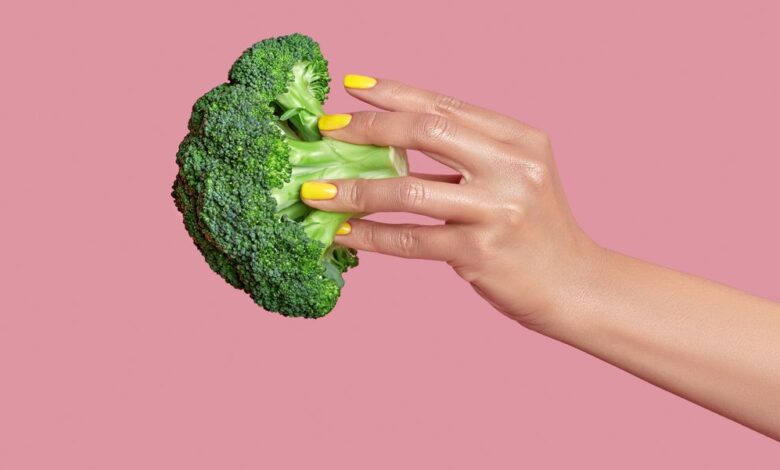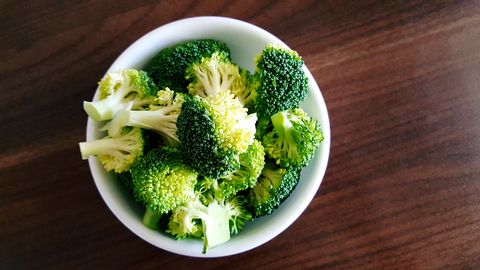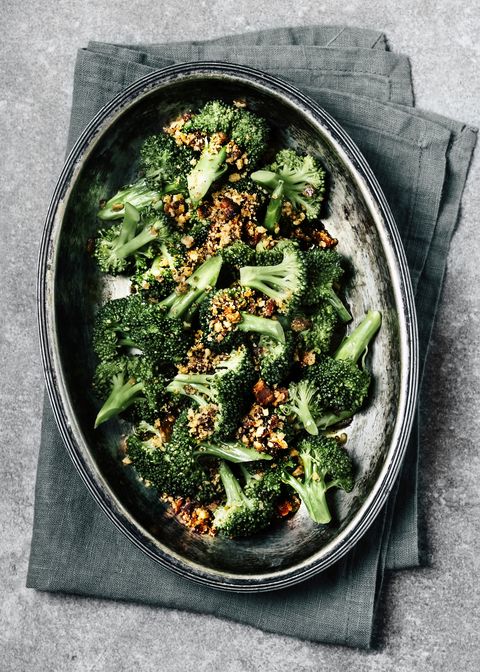7 Broccoli Health Benefits – Nutritional Facts of Broccoli

In a recent survey of more than 5,000 Americans conducted by Green Giant, consumers rated broccoli as their favorite vegetable (even surpassing carrots and corn). Not only is broccoli notorious for its nutrient-dense makeup and vibrant green color, but participants who picked broccoli as their favorite vegetable in the survey said that “taste” was a top factor in making their selection.
You already know that broccoli belongs in a healthful, plant-based diet, but this cruciferous vegetable can provide an even bigger wellness boost if you prepare it a certain way (steamed beats boiled — big time). Here’s everything you need to know about “America’s favorite veggie”, including health benefits, best cooking methods and storage tips.
This content is imported from {embed-name}. You may be able to find the same content in another format, or you may be able to find more information, at their web site.
Broccoli Nutrition Stats
Serving Size: 1 cup, chopped
- 30 calories
- 0 g total fat
- 6 g carbohydrate
- 2 g fiber
- 2.5 g protein
- 81 mg vitamin C (90% DV)
- 93 mcg vitamin K (78% DV)
- 567 IU vitamin A (64% DV)
- 57 mcg folate (14% DV)
- 288 mg potassium (6% DV)
- 19 mg magnesium (5% DV)
- 60 mg phosphorus (5% DV)
- 0.66 mg iron (4% DV)
- 43 mg calcium (3% DV)
- 0.37 mg zinc (3% DV)
The health benefits of broccoli:
Vegetables (like broccoli) belonging to the plant genus Brassica contain tons of health-promoting compounds and potentially powerful phytochemicals. These nutrients may:
- Combat inflammation: “Broccoli contains glucoraphanin, which is a compound that is converted into sulforaphane during digestion. Sulforaphane induces antioxidant activity,” says Alyssa Pike, R.D., Manager of Nutrition Communications for the International Food Information Council. Phytochemicals like sulforaphane can help fight free radicals and inflammation in the body.
- Support immunity: Did you know that a cup of broccoli contains more vitamin C than an orange? Vitamin C functions as an antioxidant and plays a major role in immune function (not to mention helping reduce risk of several chronic diseases). Plus, broccoli contains a slew of other vitamins and minerals linked to supporting a healthy immune system.
- Reduce risk of certain cancers: In general, people who eat more vegetables and fruits have lower risk of a wide range of cancers. Diets rich in cruciferous vegetable intake in particular, including broccoli, may reduce cancer risk in many tissues including lung, bladder, and prostate.
- Promote eye health: “Broccoli contains lutein and zeaxanthin, which are both antioxidants that can prevent oxidative stress and play a role in eye health,” Pike explains.
- Improve blood sugar: Broccoli contains a natural plant compound known as sulforaphane, which research suggests may improve glucose control in patients with type 2 diabetes. Broccoli is also naturally low in carbohydrates and contains fiber, making it a low-glycemic addition to any meal. Try riced broccoli as a lower carb swap for rice at any meal.
- Support a healthy heart: Broccoli is a source of several nutrients like folate, potassium and iron, all of which are vital in supporting a healthy heart. Recent research published in The British Journal of Nutrition found that participants who consumed more cruciferous veggies like broccoli had less calcium buildup in their aortas than people who ate less of these veggies.
- Promote healthy skin: In addition to being an excellent source of vitamin C which supports collagen synthesis and skin health, prior research found that sulforaphane reduced skin redness and inflammation caused by exposure to ultraviolet radiation.
Potential side effects of eating broccoli:
Most people can safely enjoy the cruciferous vegetable, but certain individuals may need to be cautious. “Broccoli contains vitamin K, and eating large amounts of broccoli could reduce the effects of the blood-thinner warfarin (also known as Coumadin),” Pike says. If you are taking warfarin, Pike adds that it’s important to speak with your healthcare provider about how to properly manage your medication and your vitamin K intake.
People with gastrointestinal conditions may also find that too much broccoli causes gas or other irritations, Pike explains, but those individuals should work with their healthcare provider to figure out what works for them; it may be as simple as reducing portion size or changing preparation method.
Now that you know the basics, get the low-down on the best way to prepare and cook broccoli to get the most antioxidants and vitamins below.
Are broccoli florets better than stalks?
Let us be clear: All parts of broccoli are nutritious! Instead of being quick to discard the stalks and leaves, get creative; shred the stalks for broccoli slaw or riced veggies and use the leaves in omelettes or stir fry. When it comes to nutrition content, research shows that broccoli florets have higher concentrations of certain nutrients like amino acids whereas the leaves are higher in carotenoids and other antioxidants. The stalks contain essential nutrients too.
Is eating broccoli raw better than cooked?
Although both raw and cooked broccoli are nutritious, some cooking and preparation methods are ideal. “Raw broccoli is rich in vitamin C, and cooking broccoli will slightly reduce its vitamin C content,” Pike says. That’s because vitamin C and glucosinolates in broccoli are water-soluble, which makes them more susceptible to loss during the cooking process. She adds that boiled broccoli retains only 40% of the phenolic content of the raw vegetable. “Steaming or microwaving helps broccoli retain more vitamin C than boiling it, so raw or steamed may be your best bet,” Pike explains.
Tips for broccoli selection, storage and recipes:
Broccoli is best kept refrigerated and used within 3-5 days of purchase. “Look for broccoli that is firm with deep green crowns of tightly-closed buds,” Pike advises. “The stalks should be green and fresh, not brown or yellow.” She adds that some yellow flowering at the tips is fine, but you’ll want to avoid wilted-looking florets with a lot of yellow flowering. Plus, mushiness and a rotten smell is an indication that the broccoli is no longer fresh.
Since broccoli releases ethylene gas as it sits, Pike says it’s important to let the veggie breathe by keeping it loosely wrapped in an unsealed plastic bag. “Place broccoli in a cold part of the refrigerator like the crisper drawer but away from other fruits and vegetables that also produce ethylene gas.”
Broccoli works great on its own or paired in stir fry, shredded as part of a slaw, added to a morning omelet or even as a topping on baked potatoes. Looking for some healthy broccoli recipes? Try some of our favorites:
This content is created and maintained by a third party, and imported onto this page to help users provide their email addresses. You may be able to find more information about this and similar content at piano.io
Source link



